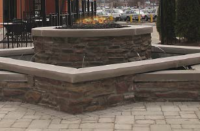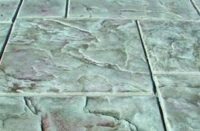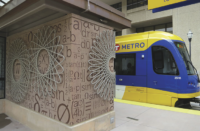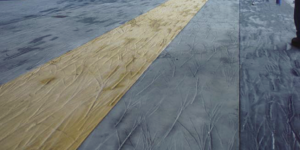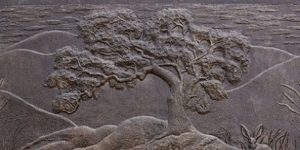The decorative concrete business has given home and property owners the opportunity to develop an aesthetically pleasing, yet durable, look outside their buildings. Steve Cook, sales and marketing manager at Kraft Tool Co., knows border tools are a big part of that look.
“A lot of people are looking for a nice border around a driveway or patio with a color concrete,” Cook says. “That’s what I find most people are looking for. Think of wallpaper with a border. It’s the same type of thought.”

In the mid-1980s, Matcrete was one of the first companies to offer soldier-course border tools for straights. A soldier course is a row of bricks or cobblestones laid long side against long side or in a stacked fashion. “Border tools have evolved from banding tools like our brick, stone and cobblestone designs into imprinting ballerinas or cowboys and Indians into a surface,” says Kris Kaitanjian, senior vice president of Matcrete.
One of Matcrete’s most popular and well-known border tools is the Classic Stone, which comes in a 9-inch by 36-inch or 18-inch by 36-inch tool. “The Classic Stone is a consortium of broken pieces of earth and rock,” says Kaitanjian. ”It has a unique appearance that only a border can get away with. It works very well as a detectable warning for vehicular traffic and maintains an organic look.”

Larry Freeman, the vice president of sales at Proline Concrete Tools, says his company’s most popular border tools are the Hammered Edge Grapevine, Dolphins, Fleur-de-lis, Acanthus Leaf, and Wild Mustangs. The Wild Mustangs are among Proline’s newest borders, along with Tropical Fish.
Cook says Kraft Tool has not introduced any new border tools recently, but the company does sell a variety of single and double edgers, some with groovers.
When it comes to patterns on the concrete, there is no right or wrong answer when deciding whether to use repetitive or abstract patterns. Cook says he thinks that while repetitive patterns look better on long lengths of concrete, “it depends on the job and the look you want.”
“It depends on the imagination and creativity of the owner,” says Freeman. “While a repeating border like the grapevine or the Mustangs would impress many, as well as be very easy to use on a long run, the more imaginative individual would probably want to incorporate our individual accent pieces like the butterfly, dragonfly, hummingbird or moose. They are the right size to work around any of Proline’s decorative border tools.”

In addition to the borders, the stamps are vital to creating the right look and pattern.“We introduced miter stamps and radius tools for decorating the corners of the borders where the soldier courses were used or half rounds were desired … so that a border would not just start and stop but have a continuous flow and maintain a free form,” says Kaitanjian. “Those stamps were created to eliminate the inevitable symptoms of laid brick, cobbles and pavers when used alongside a different field pattern.” At Matcrete, the stamps are made so the look of the concrete resembles natural materials in both traditional styles

and contemporary patterns.
Stamps continue to evolve. Bon Tool Co. introduced new Border Concrete Stamps and Bon Detail Stamps at the 2007 World of Concrete show. Bon marketing manager Michele Bender says the new stamps “will be a neat idea as an alternative to the natural brick and stone look of traditional stamps.”
The type of look desired may also have something to do with geographic area. “European markets seem to be using the very traditional ashlar, Appian and cobblestone styles,” says Freeman of Proline. “The U.S. market seems very similar. However, the Random Stone, Belgium Slate and Random Boardwalk are all good sellers. Casinos seem to be big on the seamless texture mats. The Wild Mustangs are big, of course, in horse country, and the Tropical Fish border as well as the Coquina With Shells are big in the coastal states.”
